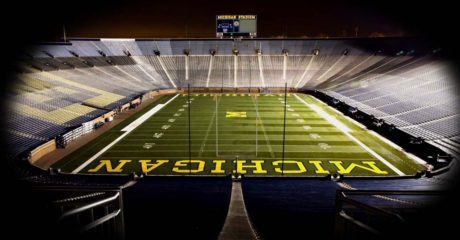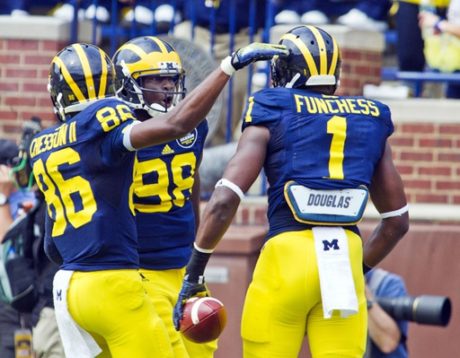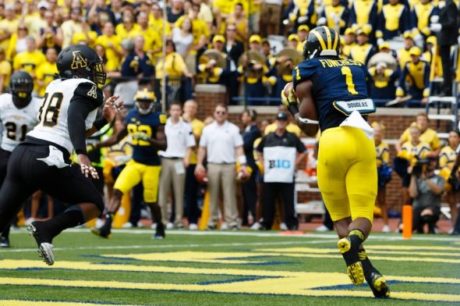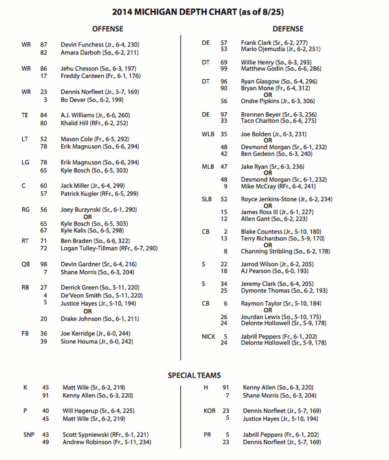 |
| Devin Funchess had three of these touchdowns on the day (image via Fansided) |
The Doug Nussmeier Effect: Quarterbacks. Yes, it was only newly minted FBS team Appalachian State, but starting quarterback Devin Gardner looked about as good as possible. He was 13/14 for 173 yards, 3 touchdowns, and 0 interceptions; he also ran 5 times for 9 yards. Best of all, he made good decisions and his only miss was a laser that fell harmlessly to the turf behind a crossing receiver. I think Nussmeier will use him more often as a runner as the game and situation dictate, but there’s no need to get him banged up in a blowout against ASU. Backup Shane Morris (3/5, 37 yards, 1 interception) looked a little shaky, especially on a comeback throw that never should have been released and got picked off by an undercutting corner. That’s now 0 touchdowns and 3 interceptions thrown in his career.
The Doug Nussmeier Effect: Running Game. Opponent caveats apply, but Michigan struggled early before quickly finding a rhythm. The combo blocks looked cleaner and the offensive line looked crisper than they did at almost any time last year. The running backs combined for 31 carries, 345 yards, and 3 touchdowns. The inside zone run seemed ineffective at times because Michigan couldn’t get a great push. That’s a Nussmeier favorite, so they will surely continue to work on that play. Interestingly, Michigan’s revamped power play seems to have improved, even though that was a supposed staple of Al Borges’s offense and not considered to be a Nussmeier specialty. Perhaps Appalachian State was surprised, or maybe Michigan just executed the power really well in game one.
The Doug Nussmeier Effect: Running Backs. I would have to go back and check to be sure, but it seemed like Michigan really struggled early when they tried to run inside zone. Derrick Green (15 carries, 170 yards, 1 touchdown) got the first series of snaps, and his vision has always been somewhat questionable; those carries did not go well. When he returned to the game, Nussmeier ran power with him. Green hit the hole hard and did well. Meanwhile, for whatever reason(s), De’Veon Smith (8 carries, 115 yards, 2 touchdowns) seemed to get a little better blocking on inside zone plays, and his vision paid off with some nice runs. Green is leaner and quicker than last year, and Smith is what we thought he was. When the offensive line opens holes, they are capable of making some things happen. Drake Johnson (3 carries, 28 yards), Justice Hayes (4 carries, 23 yards), and Wyatt Shallman (1 carry, 5 yards) got some run late in the game, but Green and Smith clearly seem to be the top two options.
Devin Funchess is wearing the #1 jersey. Funchess is the first Michigan player to wear the #1 jersey since Braylon Edwards in 2004. Brady Hoke said that Funchess asked to wear it, so perhaps that’s the difference, but it seems odd to me that he was given the jersey while previous standout Jeremy Gallon was not. Gallon had the same number of catches (49) and more yards (829 to 748) in his redshirt junior year than Funchess as a sophomore, and you could tell he was in for a big year because of his connection with Gardner. Gallon, of course, ended up setting receiver records last year. Regardless, Funchess looked very good on Saturday (7 catches, 95 yards, 3 touchdowns) and has the talent to fill the shoulder pads of the #1 jersey.
At least nobody can say Michigan sold out. Because they didn’t. The announced attendance was 106,811, which is the 252nd straight game of over 100,000 fans.
Freshman redshirts got burned. Reasonably this time! The only true freshmen to play in the game against Appalachian State were Freddy Canteen, Mason Cole, Bryan Mone, and Jabrill Peppers. This would be excellent news if it holds up, because that means Michigan can save some of its highly touted recruits all the way until they’re 22 or 23 years old. I do believe that a couple more freshmen might play this season, especially weakside end Lawrence Marshall.
How ’bout that tight pass coverage? It was pretty tight. Michigan didn’t make any picks, but they broke up three passes and came up to tackle well. Jourdan Lewis is as sticky as they come, and he’s just a backup. I thought new safety Jeremy Clark looked pretty good in Delano Hill’s absence.
How ’bout that defensive line? When it comes to the defensive line, I actually don’t think we learned much. If the quarterback held the ball for longer than the play was designed for, he was usually getting hit. Fortunately for the Mountaineers, that wasn’t often. Pretty much every defensive lineman bulled his way into the backfield based on sheer size and strength against an overmatched and small-ish offensive line. Appalachian State had some repeated success on their shotgun inside zone play, which also worked well for Indiana and some other teams last year. Michigan might have been able to stop it if there had been a point to do so. But really, if you’re whooping a team’s butt on the scoreboard and they want to run the ball to deplete the clock, there’s not a huge incentive to sell out for stopping that play.
JABRILL PEPPERS. Peppers made 1 nice tackle, dove to make a fair catch on a punt, and returned 1 punt for 6 yards. Then he left the game with a bum ankle. It did not look serious, and Brady Hoke agrees with the first clause of this sentence. He should be back for next week.
The offensive line can’t get any worse than last year. I agree. I really think last year’s offensive line would have still struggled to churn out yards on the ground like they did in this game. Appalachian State nose tackle Tyson Fernandez (6’2″, 330 lbs.) was a load in the middle, and defensive end Ronald Blair (6’4″, 275 lbs.) didn’t seem too shabby, either. Blair overpowered freshman left tackle Mason Cole on an inside move to sack Gardner, and defensive end Odawala Dada (6’0″, 235 lbs.) successfully juked guard Kyle Kalis on his way to a quarterback hurry. Otherwise, it was rare to see an offensive lineman beaten cleanly. There were some frustrating stalemates, and there will be plenty more – along with outright whoopings – to come this year. Michigan’s line never coagulated last year, but even if a little less talented, this group is going to be better.







